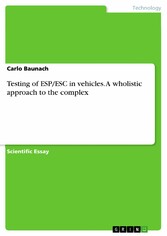Suchen und Finden
Service

Testing of ESP/ESC in vehicles. A wholistic approach to the complex
Carlo Baunach
Verlag GRIN Verlag , 2019
ISBN 9783668924369 , 9 Seiten
Format PDF
Kopierschutz frei
Geräte
Scientific Essay from the year 2018 in the subject Engineering - Automotive Engineering, grade: 1,3, Ingolstadt University of Applied Sciences, language: English, abstract: This paper analyses ESP/ESC in vehicles. Electronic stability control (=ESC) as active safety system is getting more and more common in todays vehicles. First established in 1995 by Bosch and Daimler under the well known brand ESP it has obviously prevented many accidents all around the world. Many studies show that the main target of ESC which is preventing fatal side crashes into the less resistant side components of vehicles was reached. It shows that average skilled drivers are just not able to perform the necessary measures to escape riskful lateral driving conditions on their own. This evidence and the fact that ESC is rather cheap to implement into an existing vehicle structure due to the usage of Antilock-System (=ABS) and Anti Slip Control (=ASC) hardware components led to the fact that many states passed laws which makes an ESC system mandatory in every vehicle sold in their territory. ESC is based on fundamental control engineering, vehicle dynamics, fluidmechanics as well as the combination of different energy domains (electric, mechanic, hydraulic) and is using the vehicle brakes as well as reducing engine power to stabilize vehicle behaviour in critical driving situations like over- and understeering. These circumstances can be measured, predicted and processed by several sensors and the control unit itself in order to initiate the appropriate actor reactions. Parameters that are necessary for the control algorithm but are hardly measurable with sensors like the effective friction coeffient between road and tire need to be calculated via other auxiliary variables e.g. rotational speeds. Since ESC is always in it's overall component structure the same but in its specific reaction (=control) and modeling differing due to the desired driving behaviour of a particular manufacturer, tests need to be performed to prove the stabilizing effectiveness of its output signals which are represented as brake torques and reduction of engine power. In order to perform these tests engineers need to understand the systems general behaviour (=transfer function) which makes it then possible to design different test scenarios stimulating the system, determining crucial measurement variables and analyzing their results. There are many tests concerning vehicle stability established in the industry already. These verifications can be virtually and/or physically conducted.
Shop


